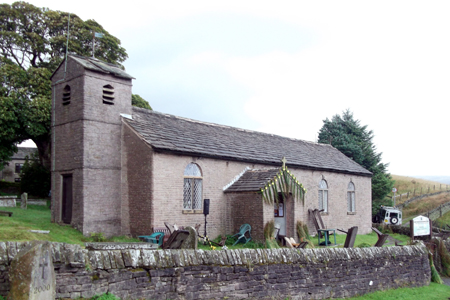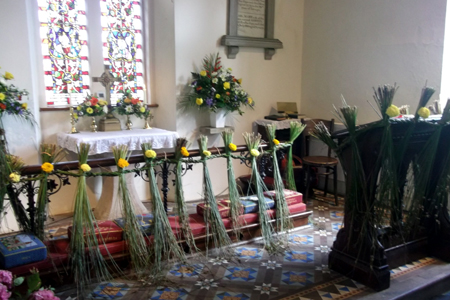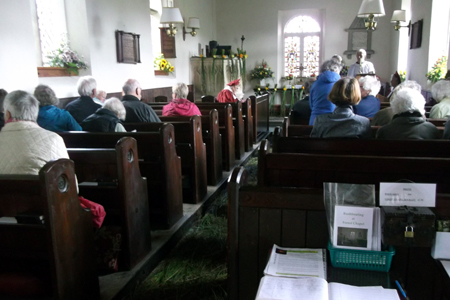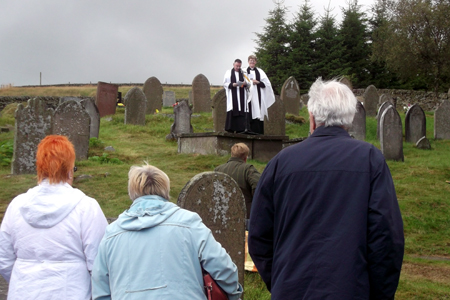| |
 |
 |
 |
| Comment on this report, or find other reports. |
 |
| Our Mystery Worshippers are volunteers who warm church pews for us around the world. If you'd like to become a Mystery Worshipper, start here. |
 |
| Find out how to reproduce this report in your church magazine or website. |
|
|
| 2748: Rush-bearing Service at Forest Chapel, Macclesfield Forest,
England |
 |
 |
 |
Mystery Worshipper:
Torold.
The church:
St Stephen's (aka Forest Chapel), Macclesfield Forest, Cheshire, England.
Denomination:
Church of England, Diocese of Chester.
The building:
This simple building of 1834, made of pink crystalline stone (Chatsworth grit, a local sandstone, quarried at Tegg’s Nose nearby), replaced an earlier chapel of 1673. A single calling bell is housed in the short west tower. The interior is plain; the whitewashed walls have wooden wainscoting. Electric "oil lamps" with parchment shades hang from ceiling throughout. Clear glass windows with leaded lights flood the interior of this charming simple little building. A Victorian coloured east window depicts the Three Kings ("of Orient are"). The nave and small chancel are one unit with no division, containing wooden choir stalls and a harmonium. The plain dark brown wooden pews have padded red seats and a ledge for books. There are old-fashioned padded hassocks for kneeling on, which I call Humpty-Dumpty kneelers. There are memorials to former resident vicars. A small white pedestal-type stone altar holds a brass cross and two small brass candlesticks, fronted by a wooden altar rail with wrought iron floral embellishment. The pulpit, which is possibly white limestone, seems a bit large for such a small building and was bedecked with bunches of reeds interspersed with marigolds. Floral arrangements were set on window sills throughout. Bunches of reeds, tied, adorned the top of the pulpit, large wooden lectern and altar rail. A white stone hexagonal font at the back was dressed with gold and white roses. The floor was strewn with rushes for the occasion.

The church:
Forest Chapel's remote setting and the beauty of the hillside make it an ideal place for prayer and reflection. There is only one Sunday service each month, but the chapel is open daily – the key is available from the old schoolhouse opposite. It draws an eclectic congregation and is popular with walkers. Many newcomers play a full part in the life of the community but are not churchgoers.
The neighbourhood:
Macclesfield is mentioned in the Domesday Book, and the name derives from the Old English word for open country – and open country it is! The church sits a little over a thousand feet above sea level, in the remote hillsides above Macclesfield. If you travel towards Buxton from Macclesfield and keep turning right after the Peak Park Millstone, you will suddenly come across this tiny hamlet nestling into the hillside, looking eastward toward the Cat and Fiddle inn. You'll find a handful of houses, no school, no pub – just peace and quiet. A century ago, the community comprised the school, the pub and a farm. The pub closed first (early in the last century), the school closed in 1961, and the farm is no longer a farm, but Forest Chapel is still open. Whether you have walked, cycled or come by car, here you will find peace and serenity in the beauty of the rolling Cheshire countryside.
The cast:
The Revd Steve Rathbone, vicar, led the service. The Venerable Ian Bishop, Archdeacon of Macclesfield, preached.
The date & time:
Sunday, 17 August 2014, 3.00pm.
What was the name of the service?
The Annual Rush-bearing Service. This custom, dating from medieval times, involved the spreading of sweet-smelling rushes on earthen church floors to provide insulation and keep the dust down. Rush-bearing gradually grew into an elaborate ceremony involving processions, the strewing of flowers, dancing, food and drink, and even costumed revelers, but it had just about died out by the 19th century. It has seen a revival in modern times, especially in the north of England.
How full was the building?
Bursting at the seams! You had to come early to get a seat. More seats were outside; the service was relayed by a public address system.
Did anyone welcome you personally?
I do not have SatNav (satellite navigation), but apparently it doesn’t work up there anyway! I was directed into a field by a gent sporting a tweed Norfolk jacket and matching hat with a feather. "Hello, love. Have you been before? No? Well, there’s a booklet at the back of church that will tell you more about it. Park over there..." I bumped my way over the grass. I soon caught up with fellow travellers, wishing I had put my walking boots on. As I approached the church along a rutted, pot-holed road full of water, another gent asked me if I had come to the rush-bearing service. The PA was belting out Meditation on a Theme from Thaïs, by Massenet. (This piece is a standing joke in our family because we always seem to have it at weddings and funerals. I can now add rush-bearing services.)
Was your pew comfortable?
As comfortable as it could be.
How would you describe the pre-service
atmosphere?
I took my place in one of the pews and listened to the lady organist delicately playing "Nearer my God to Thee" on the harmonium. The church began to fill up nicely behind me. Five minutes before the service, the bell began to ring. It was drowned out by the racket from the assembled congregation – everyone was talking at the top of their voices. One gentleman, who I found out later was the Earl of Derby, was respectfully saying his prayers, head buried in his hands, in one of the pews. Then the choir trooped in, men and women in crimson gowns and Canterbury caps, taking their places in the choir pews. The organist struck up "Angel Voices Ever Singing"and we began the service.
What were the exact opening words of the
service?
"First of all, a big thank you to everyone who has prepared the church for today’s service. Especially, thanks to Audrey." There was a round of applause.
What books did the congregation use during the
service?
A printed order of service booklet contained the hymns, prayers and responses. In front of us on the ledges were The Holy Bible, New International Version, Complete Anglican Hymns Old and New and The Book of Common Prayer (1666).
What musical instruments were played?
A Victorian harmonium with mouse-proof pedals (the faster you pedal, the further you get from the keyboard), illuminated by two candles in brass candlesticks.
Did anything distract you?
I was struck immediately by the simplicity of this charming building. It was as if I had gone back in time to Thomas Hardy’s days; I was indeed Far from the Madding Crowd. I did find myself looking through the windows at times and out into the hills. I was also busy counting the marigolds that were plaited into the bunches of rushes adorning the pulpit and altar rail and looking at a lady in the congregation who had bright marigold-hued hair.

Was the worship stiff-upper-lip, happy clappy, or
what?
An easy-flowing, friendly service based on evensong from The Book of Common Prayer. It was rustic, folksy and nice.
Exactly how long was the sermon?
13 minutes.
On a scale of 1-10, how good was the preacher?
7 – Archdeacon Ian Bishop (one day he may be Bishop Bishop!) was interesting to listen to and his sermon was informative. We all trooped outside to listen to the sermon, with the two clerics standing on a tabletomb. At one point the archdeacon asked us if we knew how to catch a monkey. The answer is to put peanuts in a jar. The monkey will reach into the jar and make a fist around the peanuts, and then he won't be able to pass his fist back through the mouth of the jar – it won't occur to him to let go of the peanuts!
In a nutshell, what was the sermon
about?
The rush-bearing was about renewing and was a practical ceremony. God refreshes us. How cluttered and dirty our lives can be! Fresh rushes provide a clean, fresh floor. Our lives can be likened to fresh rushes: sweeping out the old and making a new start. In the gospel, the rich young man asked Jesus how to inherit the kingdom of eternal life."Go and sell all, and give it to the poor. Keep the commandments." "All these I have kept," he replied, but he still went off with a heavy heart. Like the monkey, he couldn't let go. Can we let go? We all need a fresh start sometimes. In a nutshell: break free and enjoy life through renewal of your life. Really live!

Which part of the service was like being in
heaven?
I can really say I was transported to heaven on that Sunday afternoon. When I was a child in the 1950s, there was a programme on the radio on Sunday mornings called The Chapel in the Valley. I used to listen to this, sitting on my granny’s bed. "Don’t wriggle," she’d say. "You’ll make the bed bark!" The bed would go "woof" when you turned over. It was known as the barking bed. I was in heaven right there in my granny’s bed listening to The Chapel in the Valley in the chapel in the valley on that Sunday afternoon.
And which part was like being in... er... the other place?
We all had to beat a hasty retreat back into church because the heavens began to open and there was quite a press for the door. Beware of the slippery, reed-strewn flagstones!
What happened when you hung around after the service looking lost?
Everyone was talking to everyone else, me included. I was right there in the thick of it. I spoke to a couple getting married here next month. "Will your guests be able to find it?" I asked. "I expect they'll use SatNav" was their reply. (No, they won't!) I spoke with Lord Derby without realising who he was – he had read the second lesson. I took photos for people, of people, with people. I fell over in the churchyard. It is an interesting place, full of wild flowers and lichens. I was so busy observing and not looking where I was going, down I went and flashed the whole of the Peak Forest. Sorry about that! I spoke with the vicar; I liked his jeans and walking boots combined with his red woolly sweater under his cassock. I sang "Green grow the rushes-o" with some children who were fencing with sticks.
How would you describe the after-service
coffee?
Tea, wet and warm in a Styrofoam cup; blackcurrant squash also available. I had a very nice home-made biscuit; I could have eaten the whole plastic container full, neatly ranked in rows.
How would you feel about making this church your regular (where 10 = ecstatic, 0 = terminal)?
9 – I liked it so much I would go every week if it were open.
Did the service make you feel glad to be a
Christian?
Yes. I felt a great revival going on here at the Forest Chapel.
What one thing will you remember about all this in seven days' time?
Singing the final hymn, "God be with you till we meet again", which was the signature tune for that old Sunday morning radio programme of the 1950s. |
|
|
 |
 |
 |
| We rely on voluntary donations to stay online. If you're a regular visitor to Ship of Fools, please consider supporting us. |
 |
 |
 |
| The Mystery Pilgrim |
 |
| One of our most seasoned reporters makes the Camino pilgrimage to Santiago de Compostela in Spain. Read here. |
 |
 |
 |
| London churches |
 |
| Read reports from 70 London churches, visited by a small army of Mystery Worshippers on one single Sunday. Read here. |
| |
|
|
|
|


